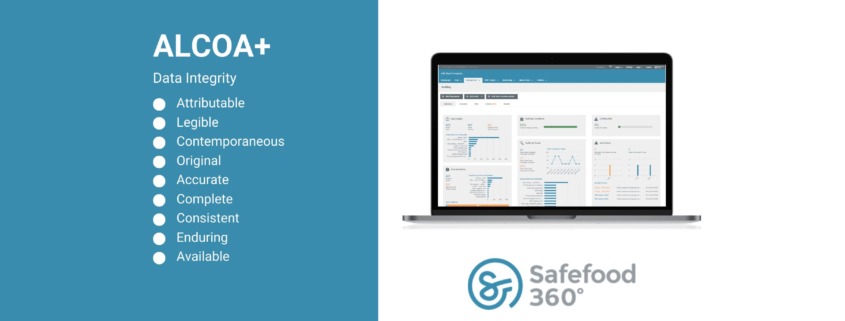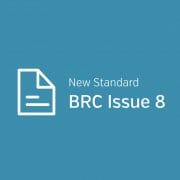Alcoa+ Principles: What can the food industry learn from life sciences
No matter where you are based, the global food manufacturing industry must comply with strict regulatory requirements, retailer demands and legal frameworks.
While the nuances of each of these asks may vary, compliance to their principles and quality standards to mitigate risk are at the heart of every action in food safety.
In this regulated landscape, maintaining data integrity is paramount, not just from a business perspective, but more importantly, ethically, it is needed to ensure that manufactured products do not cause any threat to life.
From the creation of HACCP in the 1960’s up to the modern day, the industry has grappled with evolving demands and how best to demonstrate compliance with them.
It is evident that having a standard and complying with a standard are two different demands, and the fallacy of audits to these requirements are that they present a moment frozen in time, rather than a holistic view of the real-world application of any management system.
Where records are created, they are often paper-based and islands unto themselves, presenting a microcosm of what happened on that specific day, at that specific time, and too often, do not help us determine greater learnings.
GFSI compliant schemes like BRCGS, SQF (Safe Quality Food), FSSC and IFS allow us to standardize the questions we ask of our data and uncover learnings, however, as these are ultimately industry-led, is the question worth asking, do these ask enough, or rather to be more specific, do their outputs of complying with them enable us to ask the right questions?
To answer this, this blog proposes a thought-experiment of looking at what learnings we can derive from another highly regulated industry, specifically the pharmaceutical industry.
What is ALCOA+
ALCOA+ is a set of principles designed to ensure data integrity in the pharmaceutical industry but has also become commonplace in other related healthcare and bioscience related spaces.
Quite simply, data integrity is ensuring the “completeness, consistency and accuracy of data” (Source, Page 2 https://www.fda.gov/files/drugs/published/Data-Integrity-and-Compliance-With-Current-Good-Manufacturing-Practice-Guidance-for-Industry.pdf) and ALCOA+ is a means to achieving that.
Originally introduced by the US Food and Drug Administration with a condensed scope of ‘ALCOA’, it has since expanded to include the ‘+’ and its principles can be applied to manufacturing, clinical research, testing, validation, and supply chain compliance.
In addition to evolving, the use of ALCOA+ principles have also spread and impacts how these sectors approach GMP (Good Manufacturing Practices) as well.
ALCOA is an acronym which means that a document should be something which is:
- Attributable
- Legible
- Contemporaneous
- Original
- Accurate
Further to this, the ‘+’ refers to documents that are also:
- Complete
- Consistent
- Enduring
- Available
To ensure we have a fuller understanding of each point before we consider what learnings the food industry can take from this framework, we must briefly provide an explanation for each:
Attributable
While anonymous data can be used, such as in instances of whistleblowing, to apply learnings, we must understand the context in which the data was generated.
When we say that something is attributable, therefore, we are meaning that the origin of the data itself, be it manually created by a person or automatically generated by a sensor or machine reading, is identified as well as the time and date that the measurement was taken.
While the idea of this is nothing that will be new to any reader, there are vulnerabilities that we may not consider if the necessary security provisions are not applied.
Systems that allow anonymous access, or password sharing between members of a team can expose a business to falling at the first hurdle here and disqualifying the data from being attributable.
Legible
If your company is still using manual systems, it likely is still doing so with printed forms and checklists.
While this will structure the data, it is still potentially illegible depending on the cursive skills of the person who completed the record, or indeed, the type of paper being used.
Today, in many factories around the world, paper-based records are still commonplace and in use, so it is wise to take precaution and consider the type of materials we use.
Simple things like pen thickness can impact legibility, and if your factory deploys carbon paper to improve record keeping, the thickness of sheets should be considered as simple things like the digits ‘8’ and ‘3’ can easily be confused with the degradation of each copy.
Naturally, digital systems negate many of these potential pitfalls from the off and ensure that data can be read, however, even these systems must consider their place against other ALCOA considerations.
Contemporaneous
It is critical that the records you are keeping are reflective of the moment that they are pertaining to capture.
This means data should strive to be caught when it was generated or as close to the observation as possible, so that they reflect an accurate and complete picture of circumstance.
If a record is retroactively ascribed, it is possible that details may be forgotten or neglected to be included.
While one detail may be trivial and matter in the total picture of things, if left unchecked, these can quickly compound and create an issue.
This then means that future comparisons of current data against past data may be at odds and not able to be reconciled.
Further compounding this can be a potential risk of unchecked or unknown bias, where data being sampled retroactively may skew results if the individual happens to pick samples that are less onerous to test.
Again, software systems help mitigate against this risk with complete record keeping captured at source and random sampling to prevent against bias.
Original
‘Original’ data can also be considered ‘raw’ or ‘source’ data and refers to the data in its purest form at the point of capture.
This data represents a true picture and should be preserved in its original form before any assessment or application is made to the data.
For instance, temperature or sample readings in a monitoring record refer to the original data, and readings that refer to Mass Balance or Weight Averages would be considered additional or meta data.
In a paper-based process, this data can easily be skewed, misinterpreted, or truncated as it is copied from one form or format to another.
A digital system which can capture a higher quantity of digits and thus, more of the “original data” so it avoids things like rounding, resulting in a more complete picture that more accurately represents the true circumstances of output.
Accurate
There is a quote often attributed to Grace Hopper that “one accurate measurement is worth a thousand expert opinions.”
Accuracy is implied across all facets of quality management and underpins every reading we capture.
Over the years as the sophistication of machines, sensors, and indeed our ability to record information has grown – our ability to be more accurate has become pronounced.
The benefits of electronic systems compared to paper in this regard are unparalleled.
Fueled by the acceleration of systems like Hadoop, Data Lakes, Warehouses and indeed, Data Lakehouses, we are now able to capture a large quantum of data and recall it faster than ever.
This means that we can be more precise with machine calibration, maintenance, and proactively predict wear and tear.
The result is that Accurate systems striving for Total Data Quality deliver fundamental value to the bottom line of the business across Statistical Process Controls, Thorough Put, Yield, Waste, Rework, Scrap and knowing our Takt Time.
While the above considerations provide a solid baseline for data principles, they are further complimented and enhanced by the ‘+’ which includes four more areas which can be applied to create a more robust data strategy.
Complete
There is a theory that it is not just the data for product spec that we wish to capture that we should – but rather all original data and metadata should be collected as well.
This means that the ‘golden thread’ of data covers as absolute a picture as possible and can be reconciled against one another.
This includes retests, environmental data, batching details from lot number to time of goods-forward, audit logs, sensor readings, etc.
Consistent
Record keeping must be equal in its application.
Where possible, readings should occur to a defined and rigorous schedule, recorded in the moment and any deviations from the process monitored so that its effect on the captured data can be considered.
This is a principle that is quite tricky for humans and manual systems to adhere too, as variation is all but inevitable as front-line employees work at different speeds or have ad hoc tasks to perform in any given day.
As such, outsourcing, and capturing this at source in an electronic record, can give additional peace of mind.
Enduring
Retention of records and their availability to be accessed upon demand is ital.
A strong history of data capture that is archived and inaccessible is of no use as it cannot stand the test of time.
Vendors who provide systems must also ensure that access is uninterruptable, and the right redundancies are in place.
This is why Safefood like many vendors, includes automated daily data backup, multiple records across dispersed geographical servers and best practice disaster/recall recovery support.
Available
Last, but certainly not least, data must be available to all – or at least those that are in position to use it to drive continuous improvement.
It is of little merit or value to execute the above principles only to have the data locked in an environment where it cannot be used to help enhance processes.
If the data is available to everyone, it may overwhelm, cause confusion, or indeed, potentially compromise intellectual property or competitive edge.
Putting appropriate safeguards in place that protect the extent to which this data can be accessed and retrieved can be easier with software systems rather than needing to have manual security in place to protect or monitor specific areas of your facility.
How to apply ALCOA+?
Depending on where your facility and personnel are starting from, the best way to apply the above principles is likely to divide them amongst the relevant stakeholders with separate projects for each.
A GAP assessment of current status can be a good starting point, as it will reveal gaps from your ‘as-is’ to its ‘should-be.’
Once the assessment and these potential pitfalls are known to you, you could couple this with a Failure Mode Effects Analysis to quantify the potential risk to the business, and indeed, what costs could be incurred.
The good news is operating and adhering to ALCOA+ with manual systems can be done, however, it does require ongoing maintenance, drive, oversight, and cross department co-operation.
As such, it can often be burdensome on resources and while projects typically start strong, they may decrease in effectiveness as employee churn occurs or manual creep in systems takes place.
The better news is that there are ready-made solutions in the market available today which can help, Safefood 360 is one such system.
Our software combines more than 35+ modules which are purpose built for global legislation and technical standards such as GFSI, BRCGS, SQF, FSSC, and ISO22000.
Each of these modules can replace your current systems and brings the different elements of ALCOA+ together so you can remain in step with best practices.
All of our projects are supported by a team of Food Safety Professionals who will take the pain out of a digital transformation and be more than a support to you.
These services include full set up and deployment of all records, programmes, data, and tasks, so your team can remain focused on value added activities and contributing to your company’s bottom line.
Still not sure? Click the button below and contact us to see how.










Leave a Reply
Want to join the discussion?Feel free to contribute!